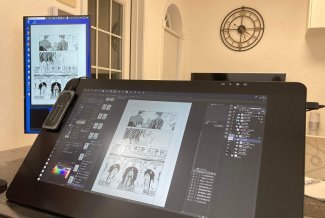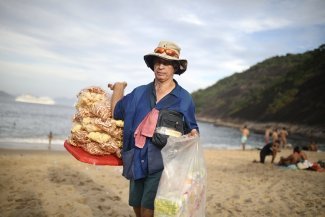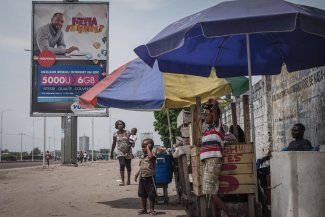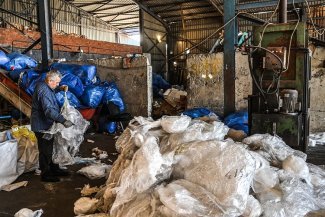
Paraguay is the country that most trusts the church in the whole of Latin America, as indicated by 82 per cent of those surveyed in a Latinobarómetro opinion poll (the average for the region was 63 per cent). The most widely followed religion is Catholicism and the church has a strong presence in everyday life and in the media. It is not unusual to see most people on a bus making the sign of the cross when passing in front of a Catholic church in Paraguay’s capital city, Asunción. And there is often confusion between what constitutes affairs of the church and affairs of the state. It is against this backdrop that an overwhelming share of the public listens without flinching to the anti-abortion, sexist and homophobic messages delivered by bishops and priests from their pulpits on a weekly basis.
The evangelical churches, for their part, whether they are just as or even more conservative, are making gains across the continent – either existing alongside or taking over from the Catholic church – and they are sparing no effort to push their agenda beyond the confines of their places of worship.
The religious lobby’s influence has direct implications for the sexual and reproductive rights of women in the South American country (cementing inequalities and perpetuating poverty): Paraguay, as human rights organisations denounce, has passed laws based on religious beliefs rather than scientific considerations, prohibiting and criminalising the termination of pregnancies, resulting in at least 45 women being tried on these grounds in 2018 and three being jailed in 2019.
In June 2020, an 11-year-old girl gave birth by caesarean section at 37 weeks, despite her and her mother’s pleas, as well as that of human rights NGOs and their lawyers, that she be allowed to have an abortion. The girl was abused by a 14-year-old boy, who has been charged: “there was no consent and force was used,” according to the Public Prosecutor’s Office.
A similar case created a media uproar around the world in 2015. Ten-year-old Mainumby, the pseudonym she was given to protect her from discrimination and harassment in her neighbourhood, was also forced to carry her pregnancy to term after being raped, in this case by her stepfather. The Public Prosecutor’s Office separated Mainumby from her mother – who was arrested and charged, without any evidence, whilst the rapist ran away – and placed her in a Catholic-run centre for abused girls, an aseptic and disciplined environment where her situation was normalised with mantras such as “girls are better mothers”.
Paraguay’s current abortion legislation is among the most restrictive in the world and only permits termination on medical grounds, if there is a risk to the development of the pregnancy or childbirth, or there is a proven threat to the mother’s life. These grounds are in fact met when an 11-year-old girl becomes pregnant, given the risks to her health and that of the foetus. But even the medical staff dealing with minors try to ensure their pregnancies are carried to term, regardless of the legislation and scientific considerations, as reported by organisations such as Amnesty International and the Latin American and Caribbean Committee for the Defense of Women’s Rights.
In addition, the persecution of human rights defenders in Paraguay has reached such a point that the government, to please Opus Dei, the Family Worship Center and other religious lobbies, banned something that does not exist: ‘gender ideology’. Even the word ‘gender’ has had to be removed from materials distributed by the Education Ministry.
“What is happening in Paraguay is part of a campaign being waged across the region to eliminate the gender perspective, labelling it ‘gender ideology’. And although there is a clearly homophobic and transphobic slant to the narrative, it is also targeting women’s rights as a whole. Any challenge to the traditional role of women is deemed unacceptable and that’s why they are starting with the education system,” Paraguayan lawyer Mirta Moragas Mereles tells Equal Times.
“The Catholic church still has the strongest influence, but evangelical churches are now coming on the scene and not only is their message very visible but they also have a great deal of economic clout,” adds Moragas Mereles. “Pressure groups can ask for all they want, but it is the state that decides whether or not they get it, and that is where the state’s responsibility begins for the backsliding,” says the lawyer.

This gigantic monument of a foetus in the womb presides over a busy junction in front of a Catholic church and the Recoleta cemetery of Asunción, the Paraguayan capital. There are replicas, declared ‘pro-life’, in other cities around the country, commemorating the ‘Day of the Unborn Child’.
Paraguay has the highest adolescent birth rate in South America, which speaks volumes about the ‘normalisation’ of this phenomenon: 72 births per 1,000 15- to 19-year-olds, according to official data. Many are the result of abuse but another contributing factor is the almost total lack of sex education in schools and poor access to contraception.

A pregnant 11-year-old chats with other pregnant young girls at the Casa Rosa Maria shelter in Asunción, Paraguay, before attending one of the limited range of classes offered to them (hairdressing, manicure or sewing), aimed at enabling the girls to earn a living from these activities in the future.
Reported cases of sexual abuse targeting pre-teen and adolescent girls rose from one a day in 2008 to 20 a day in 2020. The number of child protection violations shot up during the two-month lockdown imposed in response to the Covid-19 pandemic. More than twice as many reports were filed as during the same period in 2019 – some 4,700 in total, of which 327 were for sexual abuse – according to the Ministry for Children and Adolescents.

A girl living at the Casa Rosa Maria shelter walks with her child in the covered area of the courtyard.
It is almost 10 in the morning, on a spring day. On entering the shelter for pregnant girls, we are welcomed by a large photograph hanging on the wall, presiding over the entrance hall. It is a picture of the girl from whom the refuge takes its name. A devout woman, aged around 60, with red nail polish on her fingernails and rosary beads in her hand, is in charge of the day-to-day management of the shelter, which houses some 14 girls who have suffered from abuse and have not only been left pregnant but have also been left on their own.

The courtyard of the shelter that describes itself as a ‘life help centre’. After giving birth, the girls stay there for about a year, until they are taken in by a relative or their parents.
“The risk of mortality for teenage mothers is higher. An adolescent mother is twice as likely to die before or during childbirth as an adult mother, and a mother aged under 15 is four times more likely,” underlines Federico Tobar, regional advisor to the United Nations Population Fund (UNFPA). He also stresses that teenage pregnancy is most prevalent among people with fewer resources and therefore perpetuates the poverty cycle.

The shelter has a chapel with church pews looking onto an array of religious images and icons. Paraguay is still a predominantly Catholic country.
The criminalisation of pregnancy termination means that minors, often victims of rape, have no choice but to continue with the pregnancy, regardless of their wishes. A study by the Paraguayan Centre for Population Studies (CEPEP) nonetheless estimated – in the absence of official data – that 32,237 women of childbearing age (15-44 years) may have had abortions in 2012.

The sewing workshop, decorated with pictures of the Virgin Mary. Religious instruction is at the heart of everything in the shelter.
The girls at the centre cook, clean and pray every day. The only variation in their routine are the classes on how to feed their future babies and hairdressing. Almost all of them look astonished on seeing two unknown men at the centre, myself and a fellow journalist, accompanied by a social worker and an Amnesty International facilitator.

Hairdressing classes, the girls’ favourite activity at the shelter.
The atmosphere is one of discipline. In the absence of sufficient human and material resources to meet the girls’ needs, some of them try to run away, living in fear and going hungry on the streets. But this is perhaps the only place they have left in the world where they have a chance of not suffering something worse than what has already happened to them.

A pregnant girl at the shelter. This is one of the places where the Public Prosecutor’s Office sends sexual abuse victims. The aim is to help them, but the only option they are presented with in such places is to go ahead with the pregnancy.
Aside from the impact on the girls’ mental health, the economic impact is also considerable, both for the girls as individuals and for society as a whole. According to a UNFPA report, “adolescent pregnancy generates annual losses of over 703 billion guaranies (US$100 million, €85 million) in terms of female productive activity and 64 billion guaranies (around US$9 million, €8 million) in terms of the cost for the state. “Child and teen pregnancy is one of the faces of inequality in Paraguay,” concludes the UNFPA.










